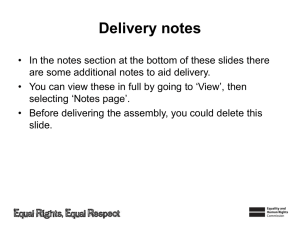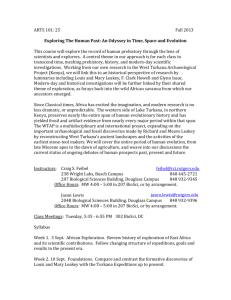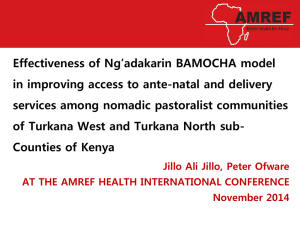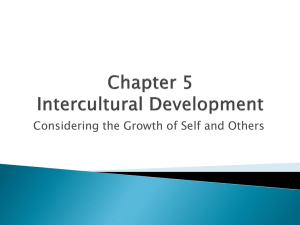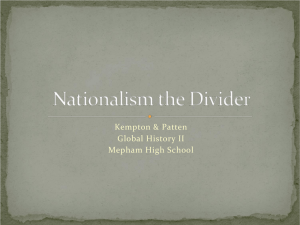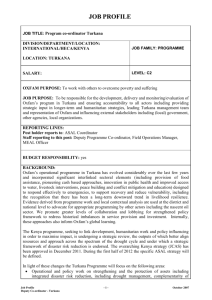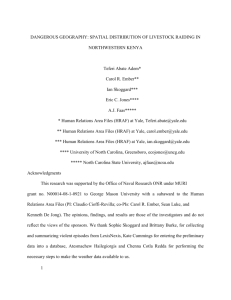presents
advertisement
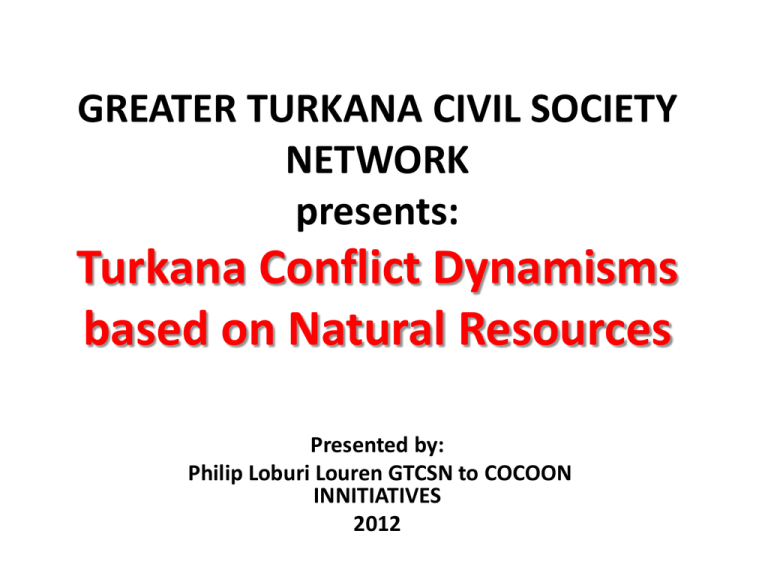
GREATER TURKANA CIVIL SOCIETY NETWORK presents: Turkana Conflict Dynamisms based on Natural Resources Presented by: Philip Loburi Louren GTCSN to COCOON INNITIATIVES 2012 Greater Turkana Civil Society network The organization was started on the 5th February 2,000, with an objective of giving voice to local organizations. This followed the recommendation made by members of District Steering Group (D.S.G.), a body that supervises and coordinates development activities in what was formerly referred as Turkana District (and now Turkana County), in one of their meetings, that as little is known about the development activities of local organisations, an umbrella organisation should be formed so as to have a representative sitting in the District Steering Group now referred to as COUNTY STEERING GROUP(DSG) who would be giving a report of development tasks performed by local organisations. Conflict Dynamism Highlights Activity constitutional highlights •Turkana people are among the communities living along the Northern corridor of Kenya, in rift valley province. They occupy the Turkana County and they depend on pastoralism as they main livelihood, followed by fishing, agro –pastoralism, petty trade, and employment. In terms of citizenship, the depressed, starving, poor and the most insecure people are part of the 40 million strong Kenyans that the constitution of Kenya in chapter four (4) part 1, section 19; 1, 2, and 3 (a), (b), and (c). Chapter fourteen (14) about National security; part 1, section 238 guarantees protection. Conflict Dynamism Highlights •Also on the same, the African Charter on Human and Peoples’ Rights; Articles 1; which state that the Member State of the Organizations of African Unity parties to the present Charter shall recognize the rights, duties and freedoms enshrined in this Charter and shall undertake to adopt legislative or other measures to give effect to them. Article 3; 1). Every individual shall be equal before the law. 2). Every individual shall be entitled to equal protection of the law. •Article 22 (1). All peoples shall have the right to their economic, social and cultural development with due regard to their freedom and identity and in the equal enjoyment of the common heritage of mankind. •Article 23 (1). All peoples shall have the right to national and international peace and security. Conflict Dynamism Highlights •The principals of solidarity and friendly relations implicitly affirmed by the Charter of the United Nations and affirmed by that of the organization of African Unity shall govern relations between states. •Articles 24: All peoples shall have the right to a general satisfactory environment, favorable to their development. •It is therefore in this observation that we prepare this report to inform our intended legal action against the government’s criminal negligence. The criminal neglect and silence has allowed the Militia from Ethiopia, Uganda and Sudan to continually slaughter, massacre and abduct Turkana people. Conflict Frame works under GTCSN •The framework of Conflict Resolution and Reconciliation •constitutes an inclusive paradigm within which issues of •Justice, Peace, Development and Integrity of Creation need to be situated and addressed by all religious groups and associated organizations of humanitarian concern. •This paradigm corresponds most favorably with the far reaching changes that are taking place in International Relations, Development and Peace Study strategies today. Conflict Frame works under GTCSN •There is also a thrust forward towards understanding peace, development and reconciliation as inseparable dimension of religious and humanitarian activity. • There is an indispensable need for reconciliation if genuine development of peoples is to take place. • To engage in religious activity, concerned with peace, development human rights and freedom of worship without addressing conflict resolution and reconciliation, both in theory and practice is inconsistent and contradictory. Conflict Frame works under GTCSN Annex •TODONYANG CONFLICT REPORT •Greater Turkana Civil Society Network visited Todonyang area where the opinion leaders and community members of Lowareng’ak were interviewed on the happenings of the two massacres and their reactions. The team was lead by the CEO Mr. Eliud Emeri, Brent Eleman and Bakar Angela Citizen (royal media). With the help of the St. Pauls’s Missionary priest Fr. Ochieng of Todonyang Parish the following information was gathered. The Five factors identified by GTCSN on Natural Resource Conflict 1. 2. 3. 4. 5. Scarcity Marginalization-aggression Insecurity “Us" versus “them" contrast Long-standing animosity Factor 1: Scarcity Variable 2. Government sending security to stop ethnic based violence 11. Pasture scarcity 12. Water scarcity 13. Food scarcity 14. Livestock Scarcity (prolonged drought) 15. Inadequate security personnel 25. If vengeance wasn't performed by your community relations would be better 32. Greed is the ultimate cause of conflict 16. Scarcity of alternatives to pastoralism Factor 2: Marginalization-aggression Variable 3. Injustice against one ethnic community 4. Extreme poverty 5. Loss of livestock through theft/raiding 6. Competition for water holes 7. Competition for pasture 8. Killing of members of your ethnic 9. Distrust of a neighbouring ethnic community 10. Revenge for murdered fellow ethnic and/or raided livestock Factor 3: Insecurity Variable 1. Elder’s Negotiations 21. Raiding and killing without taking any belongings 18. Occurrence of cattle raids only 25. If vengeance wasn't performed by your community relations would be better 26. If your community secured its cattle/own lives better, raiding and killing would not occurred 33. People who illegally carry guns 34. Seeing people under police arrest because of participation in acts of violence 35. Unprovoked culturally sanctioned violent aggression against the other Factor 4: “Us" versus “them" contrast Variable 17. Scarcity of infrastructural facilities 27. Importance of history in unifying your ethnic communities against a neighbouring ethnic community 28. Importance of language in unifying your ethnic communities against a neighbouring ethnic community 29. Importance of culture in unifying your ethnic communities against a neighbouring ethnic community 30. Importance of religion in unifying your ethnic communities against a neighbouring ethnic community 31. Possibility of remorse Factor 5: Long-standing animosity Variable 18. Occurrence of cattle raids only 19. Occurrence of cattle raids and killing when resisted 20. Occurrence of cattle raids and killing 22. Attacking because of different ethnic identity 23. Attacking/injuring/killing as a part of a rite 24. Attacking/injuring/killing because of long standing animosity Competition for benefits from the Resources in Turkana County Thank You For Your Attention!

